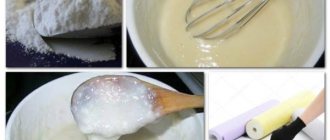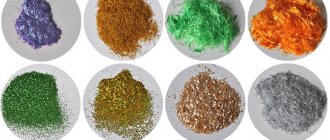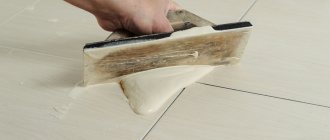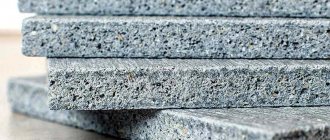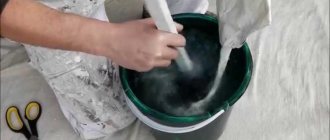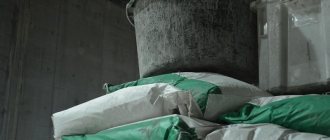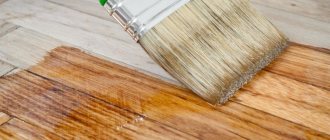How to use
Let's look at how to use the epoxy composition Litokol, and what are the features of its operation.
Before applying the mixture to the seams, the latter must be properly prepared. Namely, remove the old coating, dirt, glue and cement screed residues. Only on a clean surface will the grout last for the amount of time guaranteed by the manufacturer.
After some time, you can apply grout to the seams
Attention: it is not recommended to stir the mixture by hand; it is better to do this with a mechanical stirrer-drill
It is important that the components are thoroughly mixed together - in this case the mixture will be uniform and of high quality
Video showing the use of epoxy grout:
Do not use solvents, water, or any other additional components when preparing the mixture. Any addition of unnecessary ingredients can greatly deteriorate the adhesive, aesthetic and strength characteristics of the grout.
To apply, use a special wide spatula. The grout is applied diagonally along the seams of the tiles. During the process, it is constantly necessary to remove excess so that there are no large deposits on the surface of the tile. It is necessary to apply the composition as evenly as possible so that the overall impression of the result of the work is organic.
After grout has been applied to all seams, it is necessary to clean the surface of the tile within 45 minutes from dirt and stains left by the grout. This must be done quickly; after hardening, the epoxy mixture will be difficult to remove with anything, only with caustic solvents. To make the tile surface clean, you need to use a damp cloth or a rubber spatula soaked in water and remove the grout using wide circular movements.
Then you need to wait until the mixture dries completely
The waiting time depends on several factors: it is important that the room has a suitable temperature - from plus 16 to plus 25 degrees. And second: different grout compositions dry differently
After the cleaning activities are completed, it is recommended to walk on the tiles no earlier than a day later. And for the composition to completely harden, it will take about 5 days.
The consumption of the grout mixture depends on the width of the tile used. It is clear that the larger the area of the tile, the less grout it will require, and vice versa - the smaller the tile, the more fastening grouting composition will be needed. The width of the joints between the tiles is also important.
Grout calculator
Important to know
The calculator contains general average data that can be used for preliminary calculations.
It is recommended to increase the calculated consumption of the grout mixture by 10%, taking into account possible errors during operation.
If you don't see the calculator, follow the link.
Formula for cement and epoxy grout for manual calculation:
Consumption (kg/m²) = (a + b) / (a * b) * c * d * e,
Where:
- a - tile length (mm),
- b - tile width (mm),
- c - tile thickness (mm),
- d—seam width (mm),
- e — grout density (kg/dm³), . 1.5 - Epoxy grouts. 1.9 - cement grouts
Instructions for use
Each package of epoxy grout for Litokol tiles comes with detailed instructions, which are recommended to be read before using the material. We present the main provisions of the instructions, as well as advice from experienced craftsmen who will help you master high-quality sealing of tile joints with epoxy-based grout.
How to divorce?
To obtain a working mixture, it is necessary to mix the bulk with a liquid hardener. The main thing you need to know before you start mixing: the mixture must be used up within 40 minutes. After this period, the epoxy grout hardens and becomes unusable.
In 40 minutes, it is necessary not only to seal the seams, but also to rinse the treated surface with water. Therefore, you need to mix the mixture components in small portions. For beginners, for the first time it is enough to dilute 200-250 g of the mixture.
To prepare the grout you will need:
- scales;
- clean plastic container;
- mixing spatula;
- latex gloves.
Dilute the mixture in a proportion of 8 g of liquid hardener for every 100 g of epoxy mass; this proportion should be clarified in the instructions for the grout.
Let's describe this process step by step:
- The corner of the bag with the hardener is cut off to create a small hole. This will allow you to store the opened package for a long time.
- Place the container on the scale and pour the calculated amount of hardener into it, for example, 20 g.
- Using a spatula, add the epoxy mixture to the same container in the calculated amount, for our example - 250 g.
- Remove the container from the scales and thoroughly mix the contents with a spatula until the liquid fraction completely disappears and the mixture becomes homogeneous.
It is not recommended to use mixers with a high number of revolutions for stirring, since if the rotation is too fast, the mixture self-heats and its hardening time is reduced.
How to apply?
Before preparing the grout, the surface for its application must be completely prepared. The optimal air temperature for work is +18-23°C; at temperatures below +12°C it is not recommended to use epoxy grout.
It is convenient to rub the seams with a special rubber float. The grout is applied to the float with a spatula, then the material is spread with a float over the surface of the tile with diagonal movements, rubbing into the seams. Use the edge of a grater to scrape the mixture off the tiles and rub it back into the joints.
To grout the corners, use a spatula and a special corner with a 45° chamfer. After using all the diluted mixture, the treated area is cleaned with a clean rubber float and poured with plenty of cold water, after which it is wiped with a cellulose sponge, rinsing it thoroughly. This helps to create an even and smooth surface for the seams.
After grouting, a film appears on the surface of the tile from the epoxy mixture, which must be removed the next day, otherwise indelible yellow stains will remain. This is done using a special product called Litonet, which is applied every other day according to the instructions and left for half an hour. After this, the surface is washed with water using a stiff brush or white felt and wiped dry with a cotton cloth.
Only on the fifth day after cleaning can you begin using the treated surface. Before this, you should not cover it, splash it with water or other liquids, walk on it, place objects on it, or expose it to temperature changes. Therefore, it is advisable to lay the floor tiles last.
Advantages and disadvantages of Litokol
Epoxy grout has undeniable advantages over traditional ones:
- Available in 103 exclusive colors. This variety is achieved by adding special additives, for example, glitter and so on.
- Stable color. It does not fade during its service life. Does not change color when exposed to ultraviolet rays.
- There is no staining effect. When applying the mixture to an easily absorbed and porous surface (granite, natural stone, mosaic), you must be careful. There is a risk of stains. Therefore, a small area is first puttyed. Contrasting colors are also not used.
- Resistant to stains. Does not leave stains from coffee, wine, tea and other liquids. Washing off any dirt is easy.
- The formation of fungus is excluded. The cement mixture can provoke the formation of fungus. The special composition of epoxy grout completely eliminates this.
- Does not settle when curing. After applying the grout and during the curing process, the mixture does not shrink. This is an important property for finishing without a chamfer.
- Resistant to deformation.
- Abrasion resistance. Epoxy grout is used in places with high intensity, for example, at metro stations, shopping centers, railway stations and the like.
- Waterproof. Litokol is an excellent grout for the bathroom. It does not allow moisture to pass through at all. This eliminates the possibility of moisture absorption into the floor slab.
- Resistance to chemicals, alkalis, acids and other aggressive environments. Epoxy grout is used in car repair shops and similar premises.
With all the positive aspects of this mixture for joints, there are also negative aspects:
- High price. It is necessary to purchase not only two-component grout, but also a grout and plaque remover.
- Difficulties at work. Grouting joints with epoxy grout requires experience from the master. If the technology is not followed, the grout consumption per 1 m2 increases and there is a possibility of getting rough joints. Stains may remain on the surface of the tile. After applying the grout, it is impossible to level the mixture. This is explained by high elasticity. If it is necessary to touch up, then only with a grouting sponge.
- Rough surface. Epoxy grout resembles the surface of sandpaper. This is explained by the fraction of sand used.
Usage
Preparatory work boils down to cleaning the joints from dust, mortar and glue residues
If the installation work has been carried out recently, it is important to wait until the adhesive has completely dried. Gaps for filling should be two-thirds free
If you decide to use the material yourself, then it is advisable to carry out the preparation of the mixture and further work according to the instructions:
- the hardener is poured into the paste, while at the same time trying to clean the bottom and edges of the container with a spatula; for this, a steel tool is used;
- mix the solution with a construction mixer or drill;
- the resulting mixture must be applied within one hour;
- under the tiles, the composition is applied with a spatula with teeth corresponding to the size and thickness of the tiles, the fragments are laid with significant pressure;
- the gaps between the tiles are filled with a rubber spatula and excess mortar is removed with it;
- if you need to treat a large area, it is wiser to use an electric brush with a rubberized attachment;
- Cleaning of excess grout is carried out quickly while the mixture remains elastic.
When working with Litokol Starlike grout, you should take into account the temperature; the optimal range is considered to be from +12 to +30 degrees; you should not dilute the solution with solvent or water. This product should not be used if the surface may come into contact with oleic acids.
Reviews about this material are quite contradictory, however, in most cases they are positive: impeccable moisture insulation, strength and durability of the seams are noted. These are truly high-quality products and, when used skillfully, they are ideal for various rooms and types of decoration.
Below is a video on how to properly grout joints with Litokol Starlike grout.
Features of the material
Epoxy grout consists of two components - a paste based on epoxy resin and a liquid hardener, which are mixed immediately before use. When hardened, the mixture forms a translucent solid mass with a smooth surface, which, unlike its cement counterpart, does not absorb moisture at all.
Colors
Without the addition of dyes, epoxy resin is colorless and resembles glass in its transparency. The introduction of pigments into the grout makes it possible to obtain a material of various colors, and the addition of quartz sand helps to change the degree of transparency.
Litokol epoxy grout is available in a wide range of colors, including shades of all colors of the solar spectrum, as well as black, white, gray and beige tones. This allows you to choose a color that blends harmoniously with tiles of any shade. To achieve a shimmering effect, glitter can be added to the mixture.
Features and Benefits
Compared to cement-based compounds, epoxy grout has many advantages:
- High degree of adhesion with any facing materials without the use of additional means - primers, etc.
- High strength and durability. Its service life is at least 50 years, it is so durable that it is impossible to remove it without damaging the tiles.
- Absolutely waterproof.
- The durable, smooth surface with zero water absorption prevents the growth of mold and bacteria.
- Resistance to low and high temperatures (from -20°C to +100°C), aggressive chemicals, ultraviolet radiation.
- Hypoallergenic and environmentally safe. It can be exposed to contact with food.
- High aesthetic qualities throughout the entire service life.
- Easy to care for.
Application area
Due to its absolute waterproofness, mechanical strength and high decorative qualities, epoxy grout is used:
- for lining swimming pools;
- wherever moisture resistance and strength are required - in the cladding of countertops, floors exposed to high mechanical loads, rooms with high humidity;
- where chemical resistance to aggressive environments is required;
- in rooms with high requirements for cleanliness;
- for working with glass tiles and mosaics;
- where its aesthetic properties are important.
Advantages of brand products
The manufacturer of epoxy grout Litokol is one of the most reliable companies on the market. The products produced are of high quality, and the building materials meet the stated technical and operational characteristics. The product is certified according to the international standard ISO 9001 and is represented by a wide range of Litokol products.
Cement mixtures
According to builders, working with cement-based sealants is easier than with epoxy materials. The grout composition includes a cement base, filler, coloring pigments and polymer modifiers. The size of the filler fractions determines the width of the grout joints for which a particular product can be used. Litokol cement grout has important advantages:
- Improved technical characteristics according to European standards.
- Application: walls, floors in showers, swimming pools, terraces.
- Suitable for industrial purposes, interior and exterior work.
- Has high adhesion and increased mechanical strength.
- Resistance to abrasion loads and ultraviolet radiation.
Cement compositions Litochrom1-6 and Litochrom3-15 are able to absorb vibrations between the tiles, which maintains the integrity of the seam and does not allow moisture to penetrate under the facing material. Some cement-based compounds can be used on difficult surfaces (plasterboard, heated floors) under a latex coating.
Epoxy grouts
The two-component composition Litokol, which includes a resin with fillers and modifying additives, and a catalyst-hardener, belongs to the category of epoxy mixtures. The material is suitable for interior and exterior use, which indicates its versatility of use, but most often the sealant is used to seal seams between tiles and small mosaic fragments. Litokol grout based on epoxy resin has undoubted advantages:
- High threshold of mechanical strength, low abrasion.
- Resistance to temperature changes from -20°C to +100°C.
- Immunity to ultraviolet radiation and moisture.
- Long service life exceeding 50 years.
- High compressive, tensile and deformation strength.
- Wide choice of color palette, effect of gold, silver, bronze.
- Resistance to aggressive agents, acids, alkalis.
Litokol epoxy grout is characterized by good dirt-repellent properties. Contamination from the surface of the sealant (water splashes, traces of coffee, tea, juices, fat) can be easily washed off with warm water. When exposed to direct sunlight, Litokol paste retains color saturation and shine and does not darken. After final drying, the material does not shrink - an important point when decorating walls with edgeless tiles.
Note: Before using the two-component grout Litocol, you need to take into account the high hardening speed of the composition. The seam can only be straightened with a special sponge. If the paste gets on the surface of the tile, unsightly stains may remain on it.
Grout mixtures
Epoxy composition for laying tiles and grouting
Emission Limit Values: Improved Reactive Adhesive, Thixotropic Reactive Grout
epoxy composition for laying tiles and grouting
Non-absorbent grout The product is resistant to ultraviolet radiation and weather conditions Suitable for use in swimming pools The product is patented Suitable for installation on floors with high loads Suitable for finishing surfaces in contact with food The product can be used as an adhesive and as a grout Area of application Resistant to stains Acceptable joint width for grout application High resistance to chemicals Two-component product
Description:
Two-component acid-resistant composition. Component A is a paste-like composition of a mixture of epoxy resins, silicon fillers and additives. Packaged in a plastic bucket. Component B is a catalyst of organic origin. Packaged in a bag that is placed in a jar with component A.
Advantages:
— bright saturated colors — long-lasting uniform color — complete waterproofness — does not get dirty and does not allow water to pass through — complete absence of cracks after drying — resistant to deformation and abrasion — high mechanical strength and elasticity — resistant to acids and aggressive chemicals — high adhesion to substrates — resistant to sudden temperature changes - frost-resistant - does not emit harmful substances
Application area:
Designed for laying tiles and grouting joints with a width of 1 to 15 mm indoors and outdoors: - wall and floor cladding, - tiling of the kitchen work area - heated floors - terraces and balconies - bathrooms and showers - swimming pools, incl. . with thermal or sea water - saunas, Turkish baths Recommended for surfaces exposed to contact with aggressive chemical compounds. Suitable for food industry and public catering premises: - confectionery - cheese factories - meat processing plants - breweries - dairies - wineries - creameries Suitable for all types of tiles and mosaics: - ceramic tiles, porcelain tiles - clinker - glass, metal, wooden mosaics - natural stone, marble, granite - stone mosaic - agglomerates, cobblestones - glass blocks
Characteristics:
Appearance:
Part A: thick colored paste Part B: thick liquid
Consistency:
Pasty
Permissible application temperature:
From +12 to +30 °C
Recommended application temperature:
From +18 to +23 °C
Start of walking:
After 24 hours at t +23 °C After 3 days at t +15 °C
Start of operation:
After 5 days at t +23°С After 10 days at t +15°С
Operating temperature:
-20 to +100 °C
Storage:
24 months at a temperature not lower than +8 °C
Package:
Plastic bucket 1 / 2.5 / 5 / 10 kg
Technical documentation Starlike technical card
Booklet “Starlike color scheme” Starlike booklet
Copyright All rights reserved. LITOKOL 2019
made in TRUE
Specifications
The combination of resin with a hardener and modifying additives gives the Litokol sealant good performance properties, which are an order of magnitude higher than those of cement compositions. Depending on the type of brand product, the characteristics of the grout differ slightly in material consumption, but the basic technical parameters of the mixture are identical:
- The consistency of the components of the composition is a thick paste and a thick liquid.
- Proportions – 92:8, 100:8, 100:8.3 depending on the labeling of the mixture.
- Application time until hardening is from 45 minutes to an hour.
- Complete hardening takes 5-10 days, depending on the drying temperature.
- The mixture should be applied at an optimal temperature of +12 to +30°C.
- It is frost-resistant, operating conditions from -20 to +100°C.
- Shrinkage of the material after polymerization does not exceed 1.5 mm/m.
- Chemical resistance - alkalis, acids, solvents, fuels and lubricants.
The mixtures are packaged in plastic buckets weighing from 1.5 to 10 kg. Wholesale quantities are delivered in pallets. The consumption of epoxy grout varies, depending on the viscosity of the finished paste, the size of the tile or mosaic, on average it is 1.1-1.5 kg/m2 of cladding. All grouts from the manufacturer Litokol can be used for interior work (kitchen space, bathrooms, showers, hallways) and exterior finishing (terraces, facades).
Grout mixture consumption
When choosing grout mixtures, many people wonder how much material they need to purchase. Calculating the consumption makes it possible to draw up an estimate for repairs, and, having purchased the correct amount of mixture, you will not have to be distracted from repair work by a second trip to the hardware store. Product consumption must be calculated taking into account the surface material on which it will be applied. If standard ceramic tiles were used for cladding, then the average consumption of the mixture prepared for work will be 0.5-1.0 kg/m2.
If grout is used to close the seams between mosaic tiles, then the material consumption is expected to be 1.0-1.5 kg/m2. If the grout mixture is chosen as an adhesive for surface finishing, then the average consumption is 4 kg/m2.
But several factors can affect consumption:
- Experience of the craftsman who will perform the finishing work;
- Temperature indicators in the place where finishing is carried out;
- Viscosity of the prepared composition.
Product consumption must be calculated taking into account the surface material on which it will be applied.
Litokol brand products have long established themselves as very high-quality grout mixtures. Professionals often choose them for grouting between tiles. Even a beginner can apply the product, because the mixtures are made in a convenient form, and working with them does not require additional skills. The variety of shades allows you to get a beautiful design and highlight the tiles and mosaics themselves. And the presence of special additives can help create a unique project. Good characteristics will allow the cladding to last for a long time, maintaining a pleasant appearance.
Varieties
The manufacturing company offers several types of material, each of which has its own distinctive qualities and features.
Starlike Defender is an antibacterial grout mixture for ceramics. Outwardly it resembles a paste with a thick consistency. Designed for seams from 1 to 15 mm. This is an acid-resistant two-component composition for different types of tiles, with high resistance to ultraviolet radiation. This material has good adhesion, does not emit toxic fumes, ensures a uniform color of the cladding, and destroys virtually all bacterial microorganisms.
The area of use of this product is quite large - swimming pools, window sills made of granite and marble, kitchens, bathrooms, industrial and other premises where special strength and wear resistance are required due to aggressive environmental influences.
At the moment, the manufacturer Litokol Starlike has released an innovative product - a grout based on an aqueous dispersion of polyurethane resins, which can also be used for glass mosaics with joint sizes of 1-6 mm. This composition is ready for use, does not contain aggressive and corrosive components, when filling joints with it, the mixture does not remain on the surfaces, thanks to the quartz sand filler.
Grout for joints
Grout for tile joints, for the most part, is a cement mortar sold in powder form and mixed with liquid to form a thick paste. Some varieties of this material are produced as ready-to-use mixtures in buckets. The main purpose of this paste is to fill the seams between tiles, protect against moisture and other foreign substances, support and frame its edges.
Calculator for calculating grout consumption for joints
Solutions density coefficients:
- KERAKOLL Fugalite Eco – 1.55
- KESTO Kiilto - 1.6
- LITOKOL Litochrom - 1.9
- LITOKOL Litochrom Luxury – 1.9
- LITOKOL Starlike – 1.55
- MAPEI Ultracolor Plus - 1.6
- MAPEI Kerapoxy Design - 1.6
Types of grout for joints:
- Cement-sand grout mixture based on sand and Portland cement;
- Grout mixture based on epoxy resin.
Cement-based tile grouts are dry mixtures diluted with water or liquid latex. There are three types of them: industrial cement, a mixture of latex and cement, and a dry hardener.
Epoxy resin-based tile grout consists of a hardener and resin that makes the grout more resistant to various chemical elements and makes it more impact-resistant. The price for this type of grout remains high, so it is used mainly in industrial and commercial premises.
Application area
For which surfaces can the epoxy composition Litokol be used, consider:
For covering surfaces in rooms with high humidity. These are bathtubs, showers, saunas, swimming pools.
When treating kitchen work surfaces, including the apron above the work area and the sink. For cladding and finishing of balconies and terraces
Attention: this method is suitable for those areas where the temperature in winter does not drop below minus 20 degrees. If it gets colder, the grout may not hold up. Floors with a heating system are also suitable for covering them with slabs with Litokol grout. For finishing cheese factories, mud baths, industrial complexes and other premises.
You may also be interested in learning how ceresit ce 33 super grout is used.
Types of mixtures and release forms
The Litokol brand produces various grouting products. It is easy to find Litokol tile grouts on sale, the main component of which is a cement mixture or epoxy. In addition to them, adhesives, self-leveling mixtures, latex additives, plaster mixtures and other products of this brand are presented. The specialty of the brand can be considered to be grouting products. For a variety of tasks, a suitable option is selected from several types of grout products:
- Starlike mixture C. 350 Crystal Litokol. Its scope of application is for rubbing seams between glass elements, which are made from decorative smalt when creating mosaic panels. Litokol Stirlike grout adapts to the color shade of the material;
- Translucent grout mixture Starlike Color Crystal Litokol. Used when creating mosaic finishing when it is necessary to obtain the exact color of the finishing material. Tolerates exposure to aggressive environments well. A beautiful effect is obtained on the surface; it “takes on” the colors of the finishing material. The composition must be applied quickly; it dries within an hour;
- Antibacterial grout for ceramic tiles Starlike Defender High levels of protective action against mold and mildew, and is also resistant to acids. Used to close the distance between joints when laying ceramic tiles. It is acceptable to apply in places where food products will be located;
- Epoxystuk X90 grout mixture. High resistance to water, most often chosen for surface treatment in bathrooms, swimming pools, and kitchens. Wide variety of colors. Can be applied to wall and floor coverings;
- Decorative grout Litochrom Starlike. It has a long service life, it can be processed on seams with a thickness of one to fifteen millimeters. Suitable for work outside and inside the building. It has good strength and filling density of seams;
- Epoxy grout Starlike Litokol C 310. It is impact resistant, water-repellent, the tile coating does not stain or crack over time. Has antifungal properties. Easy to apply, prolongs the life of the tile, long-lasting color;
- Grout Litokol 1-6 S. 00 based on cement. Used for sealing joints of floor and wall ceramic tiles. Designed to work with seams from 1 to 6 millimeters. Before use, dilute with water to obtain a creamy consistency that is easy to apply to the surface. Frost-resistant, highly durable, and resistant to ultraviolet rays.
Features of the epoxy mixture and its varieties
Epoxy grout Litokol consists of two components. It tolerates the negative effects of alkalis and acidic compounds. When applied and after hardening, it does not change color.
Some types of Litokol are used not only for interior but also exterior work. The grout is used for mosaics, porcelain tiles, swimming pools, natural stone, etc. Litokol has a wide range with 94 shades. You can add different effects in the form of gold, silver, metallic.
Important! The peculiarity of the use of Litokol is that it is allowed for use in buildings where there is contact with the chemical environment.
Advantages of epoxy grout:
- Excellent elasticity.
- The appearance of scratches and cracks is excluded.
- Has antifungal properties.
- High strength to mechanical stress.
- Moisture resistant.
- Operation is possible at temperatures from -20 to +100°C.
- During the entire service life, it does not change its technical characteristics.
- Doesn't fade over time.
Types of two-component epoxy grout Litokol:
| View | Description |
| Starlike C.350 Crystal | Has no color, completely transparent. Has a chameleon effect. Used for glass and artistic mosaics. Ideally combined with lighting. |
| Starlike Defender | Acid-resistant composition with antibacterial and antifungal properties. Suitable for joints up to 1.5 cm thick. Has 7 different shades. |
| Starlike Color Crystal | Used for art and glass mosaic. For all joints with a width of no more than 0.2 cm. |
| Litochrome Starlike | Used for mosaics and tiles, with joints up to 1.5 cm thick. Used for outdoor work and more. Has a luminescent effect. |
| Epoxystuk X90 | Resistant to acids. Suitable for use outdoors and beyond. |
Using grout
Branded tools from Litokol
- Combined cellulose sponge. It costs about 500-600 rubles. You can replace it with ordinary foam rubber, but it quickly becomes unusable. The sponge forms seams better and faster, and is enough for about 20-30 squares of tiles.
- Skipper. This is a special bucket with rollers for squeezing. Convenient if you constantly work with epoxy grout.
- Grater with replaceable cellulose attachment. Also used to clean up residues.
Mixing the mixture
The mixture is sold undiluted; to start working, you need to mix 2 components. Component A is epoxy resin with the addition of quartz sand, dye and plasticizer. Component B is a hardener.
After mixing the two components, you have no more than 60 minutes to use the mixture. There are certain difficulties associated with this. Initially, the components are packaged in certain proportions, and they must be followed. But it is unrealistic to use a full package alone in an hour, so you will need to manually divide the package into parts using an eye meter or scale.
Eg:
- Components A and B in Epoxystuk X90 are mixed in a ratio of 100 to 7.2 by weight.
- In Starlike C.350 Crystal – 100 to 8 by weight.
- There are no proportions in the instructions for Litochrom Starlike on the official website, but experimentally the figure was established to be 14 parts of filler to 1 part of hardener by weight (which comes out to almost the same 100 to 7.2).
Mix 2 components
Mapei Kerapoxy
To begin with, I do not recommend kneading more than 200-300 grams of the mixture.
Filling and shaping the seam
Seam filling
- We fill the seams with grout in the usual way using a small area, there is nothing special here.
- When working with epoxy grout, forming and sanding the joint must be done while the mixture is still wet, since it hardens for a long time.
- Immediately take a foam sponge, clean water and begin to wash out the seams using the traditional method. The grout must be applied to a dry surface, so we do not use the sponge to the very end so that the border of the grouted seams remains dry.
Blurring the seams
When the seam is almost ready, throw away the old sponge and take a new one, change the water and finish it. In this case, the grout will remain liquid. Mix a new portion of the mixture and repeat all operations. It is better to do internal corners in two passes: on the first day, one side of the corner is rubbed, on the second day, the other. Otherwise, when forming one side, the other will be disrupted, and you will need to devote a lot of time to this area.
Plaque removal
The next day you need to remove the epoxy coating using Litonet. It is not cheap, but it is a concentrate, so it will last a long time.
Apply the product to the surface
- Spray the surface with the product, wait according to the instructions and clean. There will be a lot of foam; it is most convenient to remove it with a self-squeezing mop or a washing vacuum cleaner.
- Using a “hairy” dishcloth (or a special cellulose sponge), remove the remaining grains of sand and plaque.
- Glossy tiles are easy to clean, so the product can be diluted with water 1 to 4. For matte surfaces, it is better to work with a concentrated solution or dilute it in small proportions (1 to 1).
- After cleaning, let the surface dry and check for gaps where plaque remains. If you paid little attention to washing with water, or you use clinker, clay tiles, terracotta, you may even need 2-3 passes. If you use relief decors, it is better to seal them in advance to save yourself some work.
LITOKOL STARLIKE two-component epoxy-based grout, gr. 1, S. 480 silver-gray (2.5 kg)
Material for grouting joints 1-15 mm wide in ceramic tiles and mosaics. The basis is epoxy resin. Suitable for work indoors and outdoors, including swimming pools and water tanks. Mold and fungi do not form on the surface of the seam. The material is resistant to acids and can be used in areas used in the food industry.
The grout consists of two components. The first (A) includes epoxy resin and silicon components, and the second (B) plays the role of a hardener. It also contains additives that protect the surface of the seam from the formation of mold and fungi.
Peculiarities
Available in containers of 3 and 5 kg. There are more than 30 shade options. The material can be used to fill joints in walls and floors that are in direct contact with water:
- bathrooms;
- shower cabins;
- kitchens;
- terraces;
- balconies;
- swimming pools;
- reservoirs (sea/thermal water);
- workshops where food products are produced.
Can be used on floors equipped with a heating system. The manufacturer also indicates that the composition can be used as a tile adhesive. The company warns that the material cannot be used with Cotto Toscana tiles.
Advantages
- During use, it retains its original shade.
- Does not allow water to pass through.
- The surface is easy to clean from dirt.
- Abrasion resistance
- The grout is resistant to chemicals (except oleic acids).
- No voids/cracks are formed during hardening.
- Versatility - suitable for exterior/interior decoration.
- Many shades, including metallic.
- UV resistance.
According to the manufacturer, the elasticity of the grout is 9 times higher than that of traditional cement-based materials. 28 days after sealing the joints, the mechanical resistance to bending is > 30 N/mm2, to compression - 45 N/mm2 (under standard conditions + 23 ° C and humidity 60%).
Preparation
The adhesive that was used on the tile/mosaic must be completely cured and dry. If there are residues in the seams, they must be removed. Seams - free more than 2/3 of the tile thickness and remove dust.
Before preparing grout and working with it, be sure to wear gloves and protect your face, as the components can irritate the skin and eyes. If the material gets into your eyes during the process, immediately wash them with soap and consult a doctor.
Mixing
To prepare the grout, the entire hardener, component B, is poured into the paste-like component A. It is necessary to ensure that the full volume of the hardener available in the container is added, since both components are packaged in strict proportions. Then the composition is mixed with a drill with a nozzle until smooth (the manufacturer does not recommend doing this manually). There should be no lumps in the mixture. The specific gravity of the solution is 1.55 kg/l. The manufacturer strongly recommends not to dilute the composition with water or solvents.
Gluing tiles
The material is applied to the base using a notched trowel (the size of the comb is selected according to the size of the tile). Then the tiles are laid and pressed. With a comb size of 4 mm per 1 m2 of surface, an average of 1.6 kg of mixture will be needed.
Grouting joints
They operate at a temperature of +18+30°C. It is possible to perform work at +8+12°C, but the viscosity of the grout will increase and it will be more difficult to apply. It will take longer to dry.
The seams are filled using a rubber spatula, evenly distributing the material and removing excess. If you have to work with a large area, you can use an electric monobrush with a rubberized spatula attachment. Please note that the grout can be used for 60 minutes.
The surface is cleaned of excess grout immediately, while the material is still wet. When cleaning, you need to make sure that the grout does not wash out of the seams and does not leave streaks on the tiles. The process is carried out manually. You can use an electric monobrush with a felt attachment. If the grout has already dried, the excess can only be removed mechanically.
Manual cleaning
The tiles are moistened with clean water and pre-cleaned with a spatula fitted with a white felt nozzle. Cleaning is carried out in a circular motion clockwise and counterclockwise. Thus, the edges of the seams are rubbed and excess material is removed. Change the felt as it gets dirty. After this, the tiles are wiped with a sponge made of hard cellulose. The seams should be smooth, and there should be no traces of grout or water left on the tiles. The sponge should also be changed when it gets dirty.
Cleaning with a monobrush
When excess grout has been removed from the tile, its surface is moistened with water and cleaned using an electric monobrush to which a felt attachment is attached. Felt is changed when it becomes dirty.
You can walk on the surface with worn seams after 24 hours. To fully exploit the surface - after 5 days at +23°C and after 10 days at +15°C.
Mix the mixture
The polyurethane type is sold ready-to-use; the epoxy composition must be mixed. The kit contains two components; they are mixed until a paste-like consistency is obtained; work after mixing must be started immediately, because the composition dries quickly. For mixing, it is more convenient to use a construction mixer, which will produce a high-quality mix, and the solution will turn out to be the desired consistency.
Mixing instructions are also included on the packaging; before starting work, you must carefully study it to know all the nuances.
For mixing, it is more convenient to use a construction mixer, which will produce a high-quality mix, and the solution will turn out to be the desired consistency.
Instructions for use
To carry out the work yourself, you need to know the procedure. Then the process will be easy, and there will be no problems during grouting. Since the compositions dry out quite quickly, you should not hesitate. Actions must be confident. Two-component formulations are packaged in different containers, one containing a paste and the other a liquid. They should be prepared before work. This stage will be discussed in detail later. Apply the composition according to the instructions described on the packaging of Litocol epoxy grout. Applications can begin after the required amount of time has passed for the solution used to lay the finishing material to dry.
If cement glue was used, then you need to wait a day. Cement mortars require a wait of 7-10 days. When finishing the wall with cement glue, you can proceed to applying grout after 4-8 hours.
Stages of work when applying grout:
- The seams are cleaned of dirt.
- The tile covering must be washed and waited for it to dry.
- The mixture is being prepared.
- The seams are covered with the mixture using a rubber spatula, and work begins from the corner.
- Excess grout material should be removed immediately after covering one or two squares.
Applications can begin after the required amount of time has passed for the solution used to lay the finishing material to dry.
If removal is done manually, then you need to wet the wall a little, without touching the seams, and wipe it with a spatula with a felt attachment, movements are made in a circular manner. Next, you need to wipe these places with a hard cellulose sponge, covering the seams at the joints.
If a monobrush is used for this process, the disc is changed as soon as it becomes dirty. A day after completion of work, the epoxy coating is removed with a special Litonet cleaning agent. This is the official product of the company, sold in the form of a concentrate that requires dilution with water. For smooth tiles, the concentrate is diluted in a ratio of 1 to 4, for matte tiles, 1 to 1.
To clean, the surface is wiped with a diluted product, then the foam is washed with a wet cloth. If plaque removal is not carried out within a day, but is carried out later, then they resort to Litosprit gel.
Excess composition should be removed no more than 20 minutes after its application, due to the fact that it may harden.
Summarizing
Working with epoxy grout has its own difficulties - you need to clean and dry the surface, it is difficult to remove plaque, the impossibility of forming internal corners within one day, the need to use a large amount of water for rinsing. In addition, the high price, durable seams and labor-intensive process do not allow mistakes, because correcting mistakes will cost much more.
But there are also undoubted advantages - dirt does not accumulate in the seams, they are easy to clean, do not change color when wet, and can be washed with any means. After processing, the seams resemble plastic, a little rough, which is why it may have a rough surface.
Whether to choose epoxy grout for grouting or not - everyone makes their own decision.
